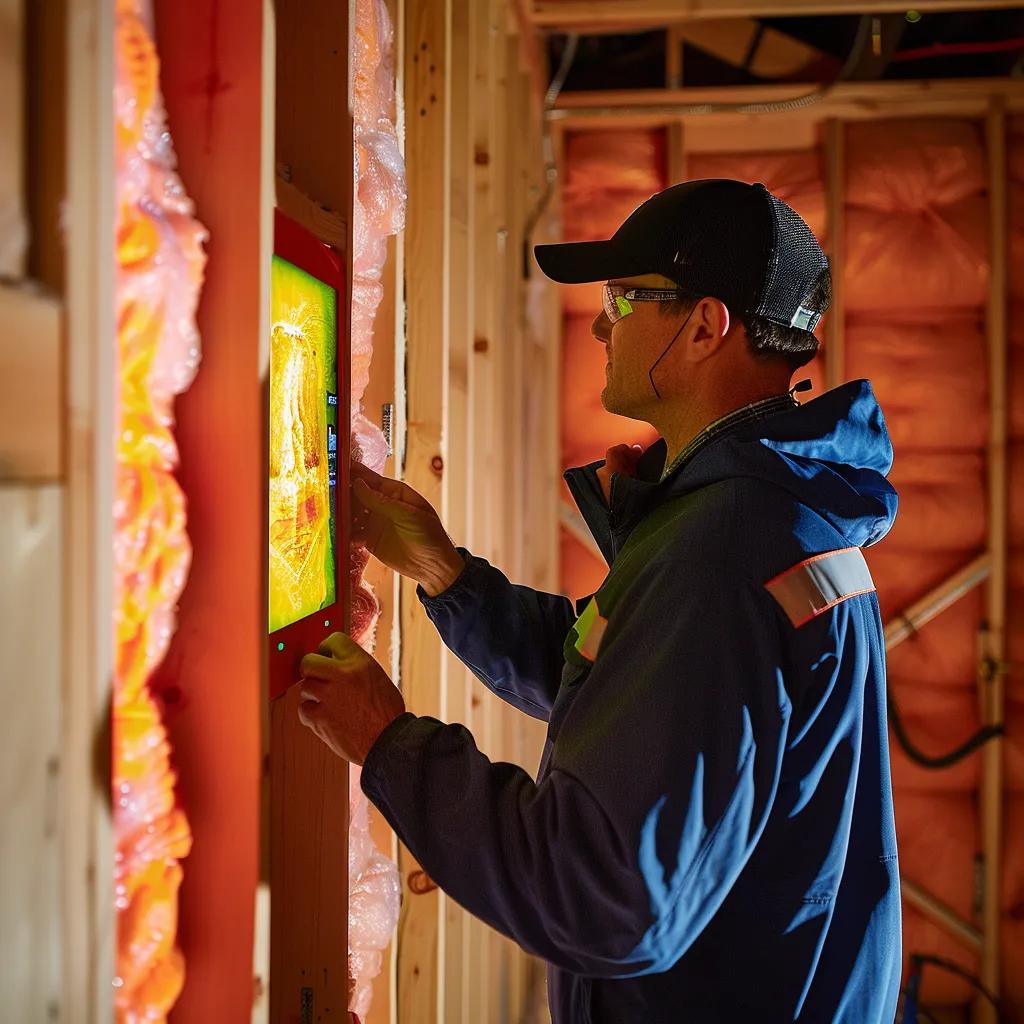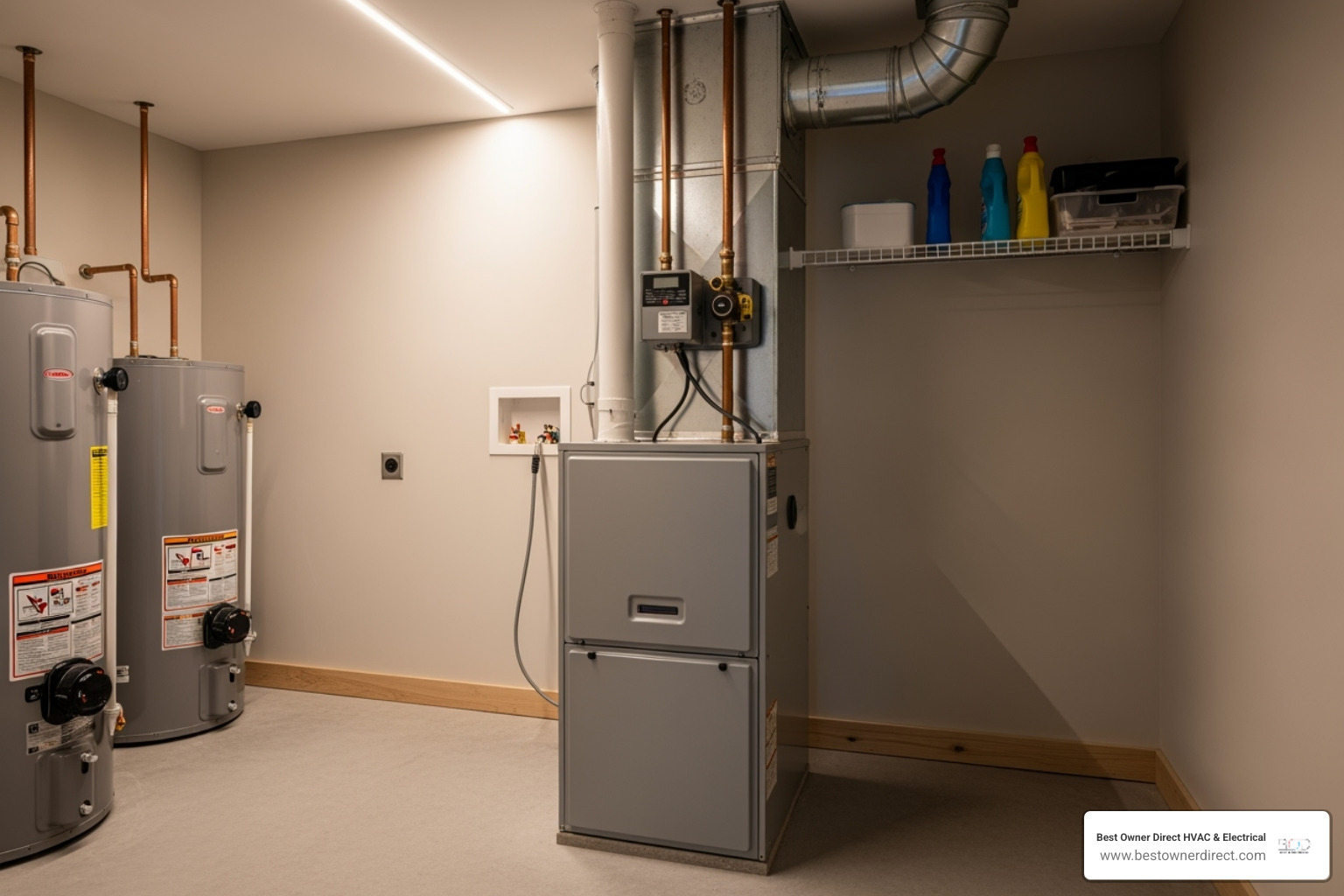Menu
Improving HVAC Energy Efficiency: Essential Tips and Tricks to Reduce Heating and Cooling Costs
Upgrading your HVAC system for better energy efficiency can slash heating and cooling costs by up to 30 percent in Portland’s variable climate. This comprehensive guide explores why efficient HVAC matters, practical energy-saving tips, smart thermostat advantages, high-return system upgrades, professional energy audits, complementary insulation strategies, and methods to track and reduce consumption. Homeowners, business owners, and property managers will find actionable advice on maintenance schedules, filter selection, duct sealing, heat pump benefits, rebate programs, and behavioral changes. Throughout, Best Owner Direct HVAC & Electrical’s expertise in duct sealing underscores how professional service can amplify savings and comfort. By the end, you’ll understand how to optimize system performance, extend equipment lifespan, and make informed decisions that lead to lower bills and a smaller carbon footprint.
Why Is HVAC Energy Efficiency Important for Portland Homes and Businesses?
Improving HVAC energy efficiency means getting more heating or cooling output for every unit of electricity or fuel consumed. That ratio directly shapes utility expenditures and indoor comfort in of cool, damp winters and warm summers. Efficient systems run less frequently, reduce temperature swings, and maintain steady airflow, resulting in consistent comfort. Recognizing this value lays the groundwork for targeted maintenance and upgrade strategies that cut bills and environmental impact simultaneously.
How Does HVAC Efficiency Impact Your Energy Bills and Comfort?
Efficient HVAC systems reduce runtime by producing heating or cooling more effectively, which lowers monthly energy expenditures. Variable-speed compressors and high SEER ratings allow systems to meet temperature targets with minimal cycling, preventing hot or cold spots. For example, a high-efficiency air conditioner can run at a lower speed for longer, smoothing indoor temperatures. The outcome is a noticeable drop in utility bills and more uniform comfort throughout living or working spaces.
Limitations of the Seasonal Energy Efficiency Ratio (SEER) for Measuring HVAC Energy Efficiency
Conventional wisdom posits that a 30% increase in the Seasonal Energy Efficiency Ratio (SEER) of a unitary air conditioner or heat pump will correspond to a 30% reduction in energy consumption. More precisely, a 30% increase in SEER yields a 30% increase in efficiency under specified rating conditions: an outdoor temperature of 82°F (27.8°C) and an indoor temperature of 80°F (26.7°C). Predicting the actual energy or demand savings of modern cooling and heating equipment using a single metric can lead to significant inaccuracies. For instance, performance data from an 18-SEER product line is compared against a 10-SEER product line from the same manufacturer.
Limitations of SEER for measuring efficiency, 2002
What Environmental Benefits Come from Improving HVAC Efficiency?
Higher HVAC energy efficiency cuts greenhouse gas emissions by reducing electricity demand and fossil fuel consumption. Lower power use eases strain on the regional grid during peak periods and supports Portland’s climate goals. Enhanced indoor air quality often accompanies efficient systems because properly sized and maintained equipment circulates and filters air more effectively, decreasing pollutants and allergens. These environmental and health improvements reinforce the value of efficiency upgrades.
How Can Energy-Efficient HVAC Systems Extend Equipment Lifespan?
Optimized HVAC operation reduces mechanical stress and wear, extending system longevity. Components like variable-speed motors and modulating burners adjust output to match demand, minimizing the frequent start-stop cycles that strain compressors and heat exchangers. Routine filter changes and calibration prevent dust buildup, while balanced airflow limits overheating. As a result, equipment requires fewer repairs and enjoys longer intervals between complete replacements, delivering better return on investment.
What Are the Most Effective HVAC Energy Saving Tips?
Energy-saving tips for HVAC combine routine care, smart controls, and system integrity tasks to reduce consumption and enhance performance. Applying these strategies can lower heating and cooling costs by 10–20 percent annually and support a healthier indoor environment. Below are essential practices that every Portland property should integrate.
How Often Should You Perform HVAC Maintenance for Maximum Efficiency?
Regular maintenance keeps systems running at peak performance and identifies emerging issues before they escalate. Professional HVAC tune-ups twice a year—once before heating season and once before cooling season—ensure components are cleaned, lubricated, and calibrated. Homeowners should check filters monthly and replace them every 1–3 months depending on usage and household conditions. Consistent maintenance reduces energy waste and extends equipment life.
Which HVAC Filter Types Improve Energy Efficiency and Air Quality?
Before installing a new filter, consider both airflow and particle capture. The table below compares common filter options for their efficiency and air-quality benefits.
How Does Proper Thermostat Programming Save Energy?
Programming your thermostat to match daily occupancy patterns minimizes unnecessary runtime.
- Lower the setpoint by 7–10°F during unoccupied hours.
- Raise the setpoint by 7–10°F when cooling isn’t needed at night.
- Use weekly programming to adjust for weekends or seasonal changes.
- Implement setback periods of at least four hours for maximum savings.
Fine-tuning these schedules prevents short cycling and reduces energy use without sacrificing comfort.
Why Is Duct Sealing Critical to Prevent Energy Loss?
Sealing leaks and gaps in ductwork prevents conditioned air from escaping into crawlspaces or attics.
- Unsealed joints can waste up to 30 percent of heated or cooled air.
- Mastic sealant or metal tape restores airtight connections at seams and plenum transitions.
- Proper sealing maintains design airflow, reducing blower runtime and energy consumption.
Ensuring duct integrity complements filter changes and thermostat programming, creating a cohesive efficiency strategy.
How Do Smart Thermostats Optimize HVAC Energy Use?
Smart thermostats integrate learning algorithms, remote control, and usage analytics to optimize . By adjusting setpoints based on occupancy, weather forecasts, and historical data, these devices can save an additional 10 percent on heating and cooling costs. Greater control and real-time feedback empower users to refine schedules and detect anomalies, building a bridge between comfort and cost savings.
What Are the Benefits of Installing a Smart Thermostat in Portland?
Installing a smart thermostat enables remote temperature adjustments via smartphone, provides energy-usage reports, and offers occupancy sensing to avoid wasted conditioning. Machine-learning models adapt to your household’s routines, automatically optimizing setbacks and recovery periods. Local weather integration prepares your system for sudden temperature shifts common in Portland’s transitional seasons, reducing spike-related energy waste.
How Do You Program a Smart Thermostat for Energy Savings?
- Connect the device to your home network and enable occupancy detection.
- Set weekdays and weekend schedules reflecting typical use patterns.
- Activate geofencing to adjust setpoints when the last phone leaves or returns home.
- Review weekly energy reports and fine-tune temperature differentials in 1–2°F increments.
These steps ensure the thermostat learns your habits and prevents unnecessary heating or cooling.
Which Smart Thermostat Features Are Best for Energy Efficiency?
Key features that drive energy savings include:
- Adaptive scheduling that learns occupancy patterns.
- Weather-aware adjustments that pre-condition spaces before peak outdoor temperatures.
- Usage analytics with actionable recommendations.
- Remote access for on-the-go setpoint changes.
Combined, these attributes form a command center for managing HVAC energy consumption with precision and ease.
What HVAC Upgrades Provide the Best Energy Efficiency Returns?
Targeted upgrades deliver the highest return on investment by improving system performance and reducing operating costs. In many Portland properties, replacing aging equipment with modern, high-efficiency alternatives recoups installation costs through energy savings within three to five years. Below is a comparison of leading upgrade options.
How Do Heat Pumps Improve Heating and Cooling Efficiency?
Heat pumps transfer heat instead of generating it, providing up to four units of heating or cooling for every unit of electricity consumed. In mild Portland winters, air-source heat pumps often outperform traditional furnaces, lowering energy use and emissions. Their reversible cycle also offers efficient summer cooling, consolidating two functions into one system.
What Are the Advantages of High-Efficiency Air Conditioners?
High-efficiency air conditioners leverage advanced compressor technology and superior refrigerants to achieve SEER ratings above 18. These systems run longer at lower speeds, reducing temperature swings and humidity levels. Improved coil designs and variable-speed fans minimize electrical draw, translating into significant reductions in summer cooling bills.
How Can Zoning Systems Reduce Energy Waste in Larger Buildings?
Zoning splits a property into independently controlled areas with motorized dampers. This approach prevents overconditioning vacant spaces and tailors temperature to specific needs—ideal for multi-floor homes or mixed-use facilities. By matching output to occupancy, zoning systems cut runtime and deliver personalized comfort, enhancing efficiency across diverse layouts.
What Local Incentives and Rebates Support Energy-Efficient HVAC Upgrades?
Portland General Electric and Energy Trust of Oregon offer rebates for high-efficiency heat pumps, smart thermostats, and duct sealing. Typical incentives include $500–1,200 for qualifying systems and up to $150 for smart controls. Combining these rebates with federal tax credits can lower net upgrade costs and shorten payback timelines.
How Can Professional Home Energy Audits Improve HVAC Efficiency?

A home energy audit evaluates building envelope performance, identifies HVAC inefficiencies, and recommends targeted improvements. Auditors use blower-door tests, infrared scanning, and duct leakage measurements to quantify energy losses. Audit findings guide prioritized retrofits that deliver measurable savings and comfort gains, offering a clear roadmap for investment.
What Does a Home Energy Audit Include for HVAC Systems?
A comprehensive audit inspects ductwork integrity, measures airflow and system efficiency, and analyzes thermostat settings. Technicians evaluate insulation levels, check refrigerant charge, and assess control responsiveness. This holistic overview highlights both immediate fixes and long-term upgrade opportunities, ensuring interventions align with efficiency goals.
How Do Energy Audits Identify HVAC Energy Waste?
By conducting blower-door depressurization and using thermal imaging, auditors pinpoint air leaks, insulation gaps, and duct losses. Data loggers track temperature differentials and runtime patterns, revealing inefficiencies in system cycling and control logic. These diagnostics uncover hidden energy drains that routine maintenance alone might miss.
How Can Best Owner Direct HVAC & Electrical Help with Energy Audits in Portland?
Best Owner Direct HVAC & Electrical offers professional home energy audits tailored to Portland’s climate and housing stock. Their technicians combine advanced diagnostic tools with local expertise to deliver clear, actionable reports. Following the audit, Best Owner Direct can implement recommended repairs, duct sealing, and smart control installations to maximize efficiency gains.
How Does Home Insulation and Air Sealing Complement HVAC Efficiency?
Effective insulation and airtightness reduce the heating and cooling load on your HVAC system, allowing it to run less frequently and at lower capacity. By minimizing heat transfer through walls, ceilings, and floors, properties maintain stable indoor temperatures. Sealing air leaks around windows, doors, and penetrations prevents conditioned air from escaping, enhancing overall system performance.
What Are the Best Insulation Practices to Reduce HVAC Load?
- Upgrading attic and roof cavities to R-49 or higher levels.
- Installing wall cavities with dense-pack cellulose or spray foam.
- Insulating basement and crawlspace joists to R-30 standards.
These upgrades limit conductive heat gain and loss, easing HVAC workload and improving comfort year-round.
How Does Air Sealing Prevent Heat Loss and Improve Comfort?
- Sealing cracks, utility penetrations, and recessed lighting fixtures with caulk or foam stops drafts that undermine thermal barriers.
- Weatherstripping exterior doors and windows enhances airtightness, while sealing duct boots at register boots prevents conditioned air leaks.
Together, these measures maintain stable indoor conditions and reduce HVAC cycling.
How Can You Understand and Reduce Your HVAC Energy Consumption?
Tracking and managing HVAC energy use begins with interpreting utility data, adopting efficient behaviors, and maintaining system health. By blending analytical review with practical adjustments, building managers and homeowners can pinpoint high-impact opportunities and sustain lower energy costs over time.
How to Read Your Energy Bill to Identify HVAC Usage?
Review your electricity or gas statement for seasonal consumption patterns and daily usage spikes. Compare HVAC-related kilowatt-hour or therm usage against non-HVAC baselines. Look for disproportionate peaks during extreme weather—these indicate potential system inefficiencies or control issues that warrant investigation.
What Simple Behavioral Changes Can Lower Heating and Cooling Costs?
- Wear layered clothing and adjust thermostats by 1–2°F.
- Use ceiling fans to improve perceived comfort at higher summer setpoints.
- Close curtains during heat waves and open them on sunny winter days.
- Schedule HVAC setbacks when rooms are unoccupied.
These small habits compound over time, delivering measurable savings without equipment changes.
How Does Regular HVAC Maintenance Affect Your Energy Consumption?
Routine inspections and filter replacements prevent dust buildup, ensure proper refrigerant levels, and maintain airflow. Well-tuned systems operate at design efficiency, avoiding the additional kilowatt-hours or fuel needed to compensate for degraded performance. Consistent maintenance thus directly translates to lower monthly energy consumption and extended equipment life.
By applying these strategies—combining professional services, targeted upgrades, smart controls, airtight envelopes, and behavior adjustments—Portland properties can achieve significant reductions in heating and cooling costs. For expert guidance, maintenance, installations, or an energy audit, contact Best Owner Direct HVAC & Electrical to schedule a service appointment and start saving today.
Conclusion
Improving HVAC energy efficiency not only reduces heating and cooling costs but also enhances indoor comfort and air quality. By implementing smart controls, regular maintenance, and targeted upgrades, homeowners can achieve significant savings while contributing to environmental sustainability. For personalized advice and expert services tailored to your needs, reach out to Best Owner Direct HVAC & Electrical today. Start your journey towards a more efficient and cost-effective HVAC system now.






